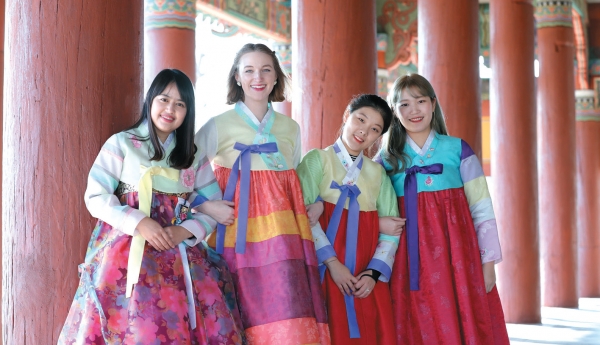
Nowadays, fashion has become globalized with modernized forms of western clothing as the standard daily wear for many people around the world. If we go back 50 years however, Koreans had their own clothing style collectively known as hanbok. Women would wear a two-piece ensemble consisting of a long skirt with an upper garment with two wide straps attached at the front that you tie together into a traditional ribbon or goreum. For men, they also wore two pieces of gar ment, pants at the bottom and a top similar to that of women but longer.
Men usually wore white garments, and women wore toneddown clothing in brown or grey for everyday life. One interesting episode is that when the French navy first made it to the upper stream of the Han River in the late nineteenth century, they decided to withdraw because most Korean men they could see were dressed in white with a tight knot at the top of their head, giving the impression of a large troop of navy soldiers in the eyes of the foreign observers.
On special occasions like weddings or on national holidays, people would abandon white and grey for more colorful and decorative clothing fit for the celebrations that occurred.
Before rubber was introduced into Korea, people usually wore shoes called gypshin made of twisted thatch strings.

Since they would easily wear out, a long journey required several pairs of extra gypshin carried on the traveler’s back. The nobility did not have to worry because they were carried around in wooden palanquins by their servants for even the shortest of journeys. No wonder they wore shoes made of silk instead of gypshin.
It was the norm for people of the Joseon Dynasty to refrain from cutting their hair because Confucian teachings guided them to preserve all their body parts, including hair, toenails and fingernails, as intact as possible because all of them were considered a gift from their parents. Before they got married, they would leave their hair down in braids for boys and girls alike. For those who were married, men formed a tight knot that sprung above the top of their heads while women tied their hair into a tight bun held together with an ornamental hairpin.
Jeong Shik Kwak
Studied political science and business management. He began working in the steel sector in 1985. Apart from his stints at an international organization and a provincial government in Korea, he has been involved in global development of the steel industry for many years. Outside work, he has a strong interest in history and comparative studies of East-West philosophy and culture. Jeong Shik has previously published his research on “the Global Scrap Market” and an essay titled “Survival and Self-esteem”.
* 《쿨투라》 2018년 12월호(통권 54호) *


